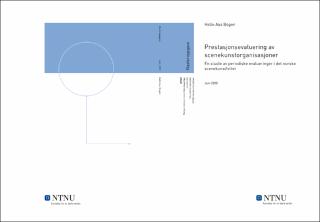| dc.contributor.advisor | Knardal, Per Ståle | |
| dc.contributor.advisor | Pettersen, Inger Johanne | |
| dc.contributor.author | Bogen, Helle Aas | |
| dc.date.accessioned | 2021-09-14T17:15:16Z | |
| dc.date.available | 2021-09-14T17:15:16Z | |
| dc.date.issued | 2020 | |
| dc.identifier | no.ntnu:inspera:55685018:60753523 | |
| dc.identifier.uri | https://hdl.handle.net/11250/2777157 | |
| dc.description.abstract | Norske scenekunstinstitusjoner mottar årlig millioner i offentlige tilskudd. Tilskuddene forvaltes av Kulturdepartementet (KUD), som etter Statens økonomistyringsreglement skal sette mål for bruk av tilskuddene og sørge for at de oppnås. I 2008 introduserte KUD innføringen av periodiske evalueringer med både kvantitative og kvalitative resultatindikatorer. Evalueringene ble gjennomført mellom 2012 og 2019, og dette var første gang en slik type periodisk evaluering ble gjennomført i det norske scenekunstfeltet. Prestasjonsevaluering av scenekunstorganisasjoner er utfordrende på grunn av organisasjonenes kompleksitet. Jeg ønsket å studere hvordan disse evalueringene ble gjennomført, opplevd og brukt. På bakgrunn av dette har jeg formulert følgende problemstilling: Hvilke roller spiller periodiske evalueringer i det norske scenekunstfeltet?
For å belyse problemstillingen har jeg intervjuet informanter fra regionale teatre, KUD og interesseorganisasjonen Norsk Teater- og Orkesterforening (NTO), i tillegg til dokumentstudier som har gitt meg innsikt i feltet og de periodiske evalueringene. Hovedfunn viser at de periodiske evalueringene har bidratt til å øke kunnskapen om hvordan teatre drives, og ført til økt bevissthet rundt ressursutnyttelse innad i teatrene. Denne informasjonen kan bidra til å legitimere KUDs rolle som tilskuddsyter, og teatrenes rolle som mottakere av betydelige offentlige midler, ved å synliggjøre hvordan midlene brukes og hva som oppnås med dem. I tillegg diskuteres hvordan evalueringsmodellen balanserer kunstneriske og administrative forhold. Evalueringen av kunstnerisk kvalitet oppleves balansert, men effektivitetskrav problematiseres fordi det oppleves å gå ut over kunstnerisk kvalitet.
For det tredje viser funnene at de periodiske evalueringene har hatt noe uklare implikasjoner. Informantene har ikke konkrete eksempler på tiltak som er kommet på bakgrunn av evalueringsresultatene, og det gjøres ikke justeringer i tilskudd som følge av dem. Uklare implikasjoner kan være et uttrykk for dekobling mellom gjennomføring av evalueringene og oppfølgingen av dem. Prinsippet om armlengdes avstand og viktigheten av identitet hos regionale teatre i det norske scenekunstfeltet identifiseres som hovedårsaker til at de periodiske evalueringene har en noe uklar rolle som beslutningsgrunnlag. | |
| dc.description.abstract | Norwegian performing arts-organizations receive millions in state funding every year. The funds are managed by the Ministry of Culture (MoC), who are bound by the state financial regulations and thereby required to establish goals for the organizations and ensure that they are achieved. In 2008, the MoC introduced a new kind of periodic evaluation combining qualitative and quantitative indicators. Performance evaluation of the performing arts is challenging because of the complexity of arts production. This thesis looks at what roles the periodic evaluations have in the Norwegian performing arts field. I have examined the following problem statement: Which roles do periodic evaluations have in the Norwegian performing arts field?
I examine the problem by interviewing informants from regional theatres, the MoC and the Norwegian Theatre- and Orchestra union. In addition, I have studied governmental documents, statements, evaluation reports and debate contributions to get an overview of the Norwegian performing arts field and the periodic evaluations I study in this thesis. The main findings from the study suggests that the periodic evaluations legitimize the MoC as manager of funding, and the theatres as recipients of funds, by increasing information about how theatres work to produce art and achieve the states goals for performing arts. Secondly, the performance evaluation model is found to balance the artistic and administrative considerations in the evaluation of quality. At the same time, the demand for improvement of efficiency seems to challenge the balance, and the art is the suffering part. Lastly, periodic evaluations have a vague role when it comes to being used as a base for decision making. The findings suggest this might be because of the arm’s length principle, which is central in the Norwegian performing arts field. Also, identity and individuality are a priority for the reginal theatres, which can keep the MoC from inflicting in the theatres artistic choices. | |
| dc.language | | |
| dc.publisher | NTNU | |
| dc.title | Prestasjonsevaluering av scenekunstorganisasjoner | |
| dc.type | Master thesis | |
